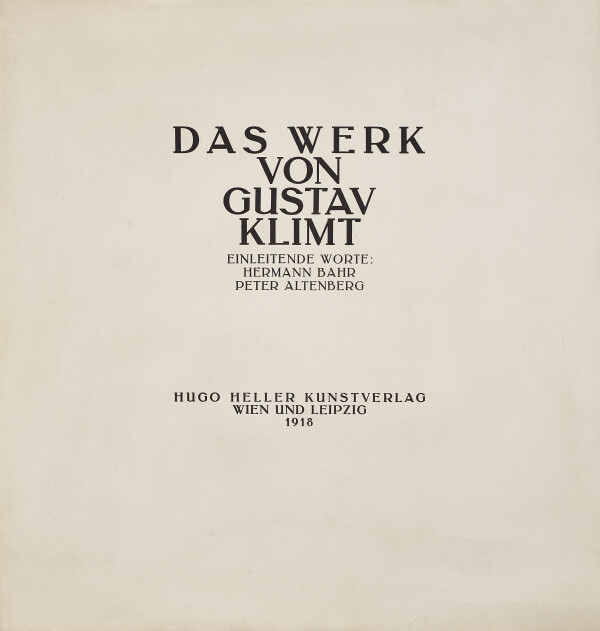Peter Altenberg

Peter Altenberg photographed by Charles Scolik
© Picture Archives and Graphics Department, Austrian National Library

Peter Altenberg at Café Central, 1907
© Wien Museum

Kunstverlag Hugo Heller (Hg.): Das Werk von Gustav Klimt, Vienna - Leipzig 1918.
© Klimt Foundation, Vienna
The Austrian writer Richard Engländer was better known under his pseudonym Peter Altenberg. As a member of the group Young Vienna, he was one of the most important representatives of the writers and poets gathering at Vienna’s cafés around 1900.
Richard Engländer was born as the son of a wealthy Jewish merchant in Vienna, where he attended the grammar school Akademisches Gymnasium. He studied medicine and botany and subsequently law in Graz, but never graduated. He moved to Stuttgart to begin an apprenticeship as a bookseller, but discontinued it and returned to Vienna.
When Engländer was 24 years old, in 1883, the psychiatrist Ludwig Schlager diagnosed him with “hypersensitivity of the nervous system” and testified to his occupational invalidity. Engländer began to write under the pen name Peter Altenberg and spent most of his time at the Café Central and the Café Herrenhof, both of which were popular especially with artists and writers. He was a member of the literary group Young Vienna, thus exchanging ideas with Hermann Bahr, Arthur Schnitzler, Hugo von Hofmannsthal and Egon Friedell. Altenberg wrote down his observations, ideas and critiques. Encouraged by Karl Kraus, he published his first work, a volume of literary sketches titled Wie ich es sehe, in 1896. Altenberg’s descriptions of everyday life, cultural events and the atmosphere that prevailed in the high society of fin-de-siécle Vienna made him one of the main representatives of literary Impressionism in Vienna.
He abandoned Judaism in 1900 and was baptized in 1910, with Adolf Loos as his godfather. Loos was one of his closest friends; together they edited the magazine Die Kunst from 1903/1904. Altenberg also contributed to the magazines Wiener Rundschau, Simplicissimus and Jugend. Further important publications include Was der Tag mir zuträgt (1901), Prodromos (1906), Märchen des Lebens (1908) and Mein Lebensabend (1919). Even though Altenberg was close friends with Loos, who strongly disliked Josef Hoffmann, and Karl Kraus, one of the most ardent critics of Gustav Klimt, he repeatedly wrote favorably about the “Kunstschau Wien” in 1908. On 8 March 1909, Altenberg even celebrated his birthday with Klimt and Hoffmann until late, as Klimt reported in a picture postcard to Emilie Flöge the next day. Altenberg wrote to Klimt on 9 March:
“[…] You create everything from a tremendous source of power, which then sublimates itself to the most tender flower in the work of art … The small tiffs you and I have had every now and then were always caused by my nervous immoderacies, never by you!”
Altenberg and Hermann Bahr later wrote the preface for the portfolio Das Werk von Gustav Klimt, released by the art publisher Hugo Heller in 1918.
Peter Altenberg led an eccentric life, he had a drinking problem, experienced “sufferings of the nervous system” and was mostly short of money. He had no apartment of his own and preferred to stay with acquaintances or at hotels. He frequently received financial support from his friends. Some of his artist friends even made a public call for donations in the Berliner Börsen-Courier in 1910:
“Peter Altenberg, who has battled a severe suffering of the nervous system for months, is now cured. Even though the poet’s closest friends have tried to somewhat alleviate the costs of his long illness, the meticulous care that he will continue to require for a long time consumes considerably greater sums than can be collected within our small circle. […] This is why we are addressing all benefactors and benefactresses of the poet, asking them to send support [...] to Peter Altenberg.”
Peter Altenberg died on 8 January 1919 in Vienna and was buried at the Central Cemetery. His eulogy was delivered by Kraus, Loos designed Altenberg’s tombstone and burial cross. His friends Karl Kraus and Egon Friedell published a selection of Peter Altenberg’s works after his death and Alfred Polgar released Der Nachlass von Peter Altenberg, a compilation of the writer’s literary legacy.
Literature and sources
- N. N.: Aufruf für Peter Altenberg von Hermann Bahr, C.D. Czeschka, Richard Dehmel, Egon Friedell, Alexander Girardi, Ludwig Thoma, Hermann Hesse, Gabriele Reuter, Alfred Kerr, Gabriele Reuter, Hugo von Hofmannsthal, Richard Schaukal, Josef Hoffmann, Emil Orlik, Max Reinhardt, Samuel Fischer, Felix Salten, Wilhelm Sternberg und Siegfried Trebitsch, in: Berliner Börsen-Courier, 14.08.1910, S. 3-4.
- Felix Czeike: Peter Altenberg, in: Felix Czeike (Hg.): Historisches Lexikon Wien, Band 1, Vienna 1992, S. 67.
- Markus Kristan: Kunstschau Wien 1908, Vienna 2016, S. 213-214.
- Meldezettel, Wiener Stadt- und Landesarchiv, Signatur 2.5.1.4.K11. Altenberg Peter. www.wien.gv.at/actaproweb2/benutzung/archive.xhtml (05/04/2020).
- Wien Geschichte Wiki. Peter Altenberg. www.geschichtewiki.wien.gv.at/Peter_Altenberg (12/28/2019).
- Brief von Peter Altenberg an Gustav Klimt (03/09/1909).
- Ansichtskarte von Gustav Klimt in Wien an Emilie Flöge in Paris, 1. Karte (Morgen) (09.03.1909).
- N. N.: Tagesneuigkeiten. Altenberg, in: Arbeiter-Zeitung, 09.03.1909, S. 5.
- -k.-: Wiener Literaten- und Künstlercafés, in: Neues Wiener Journal, 23.10.1909, S. 3-4.
- Entwurf einer Ansprache für Gustav Klimt von Peter Altenberg (12.09.1917).
- Kunstverlag Hugo Heller (Hg.): Das Werk von Gustav Klimt, Einleitende Worte: Hermann Bahr, Peter Altenberg, Leipzig - Vienna 1918, S. XXX.
- Ludwig W. Abels: Erinnerungen an Peter Altenberg, in: Neues Wiener Journal, 08.07.1923, S. 9-10.
- Österreichisches Biographisches Lexikon. Richard Engländer. www.biographien.ac.at/oebl/oebl_E/Englaender_Richard_1859_1919.xml (08/17/2022).

